Thig an fheadhainn a thig gu Eilean Ì, chan ann aon uair, ach trì tursan.
The above Gaelic saying which as been attributed to St Columba means: “Those who come to Iona will come, not once, but three times.”
In May, I was fortunate enough to fulfil this prophecy. My first visit to the Island was 15 years ago as part of a scout expedition. Those abiding memories are of torrential rain and eating a soggy bagel in the school’s bike shelter. My second took place just over a year ago in April 2023 when I became a steward at Iona Abbey for Historic Environment Scotland (HES). Now working as a Heritage trainee, I have been given the opportunity to revisit this entrancing island.
My third visit was part of a development day. I helped guide my fellow trainees around the site whilst sharing some of my favourite stories and legends. Sticking to the theme of three, I shall relate three of my favourite stories connected to the Abbey. Hopefully they entice you enough to book a ferry over to Iona soon!
St Orans
Just to the south of the Abbey complex stands Reilig Odhrainwith (St Orans graveyard). This legendary burial ground of various Gaelic, Scottish and Nordic kings is still used by the local population today. Here you’ll find St Orans chapel, the oldest building on the island.
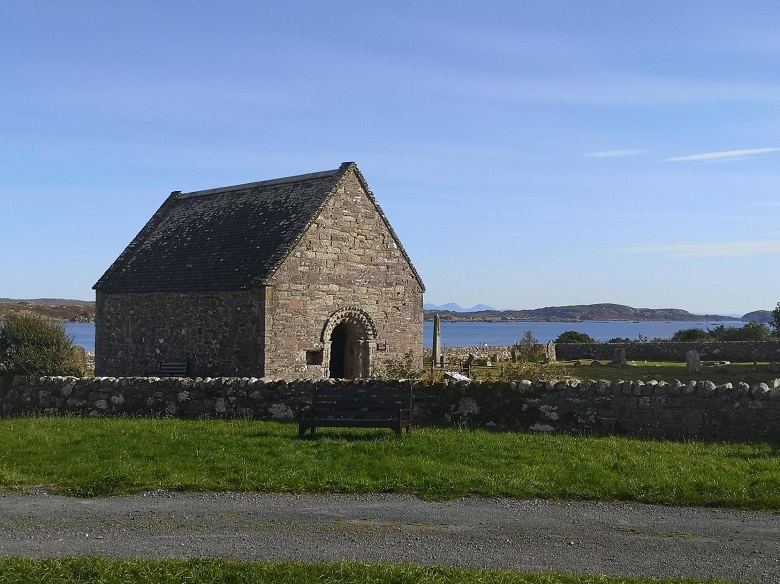
St Oran’s Chapel and Reilig Odhrainwith Sound of Iona, Mull and Paps of Jura in the background. Image © Callum Forman.
According to various legends, during construction of the graveyard and chapel for the monastery, the site was cursed for the walls to crumble every night. Sources differ as to the source of the curse. Fairies, a sea daemon and a spirit visiting Columba have all been blamed. But all legends state that a living sacrifice was needed to break the curse.
A monk of Columba’s named Oran volunteered his own life, and was buried alive beneath collapsing chapel rubble. The sacrifice was accepted and work on the chapel continued without further interruption. Grief-stricken by the sacrifice of Oran, Columba had his body disinterred three days later. Upon his grave being opened Oran was resurrected and claimed that there was neither a heaven nor hell. Fearing the impact of such words on the faith of his followers Columba ordered Oran to be reburied, proclaiming “Earth on Oran’s mouth, silence him forever.”
The story has been interpreted in several ways. Some see it as allegory of the struggles and sacrifices Columba faced when establishing the Christian religion in Pagan lands. Others see the story as a metaphor for the fusion of Christian and pre-Christian rituals and mythology, with Columba having to compromise with some aspects of Paganism to establish his church. Whatever the intention, the enduring legacy of the tale shows the continued influence of pre-Christian traditions and motifs within Celtic Christianity.
The birth of the Celtic cross
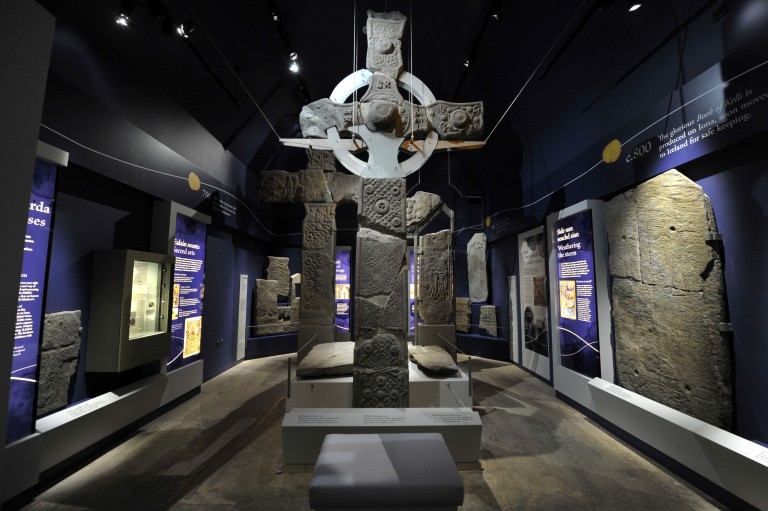
Iona Abbey Museum showing St Orans cross (left) St Johns (centre) and St Matthews (right).
Iona is very famous for its stone crosses. Some are amongst the oldest remaining structures on the island. Thanks to the writings of Abbot Adomnán in the early medieval period, the life of Saint Columba has been celebrated and popularised for centuries.
From the 700s thousands of visitors began to visit the Abbey, to pay respect at Columba’s tomb and inevitably donate a considerable amount of coin. While making their precession from Martyr’s Bay (not far from where the present jetty is) up to the abbey, pilgrims would have stopped at an original wood set of crosses to reflect and pray.
St Oran’s Cross
With greater attention being drawn to the islands and the arrival of skilled stonemasons, these were replaced by the iconic beautifully crafted stone crosses. The oldest surviving cross is St Oran’s. It is now located in the abbey museum alongside St Matthew’s and St John’s crosses.
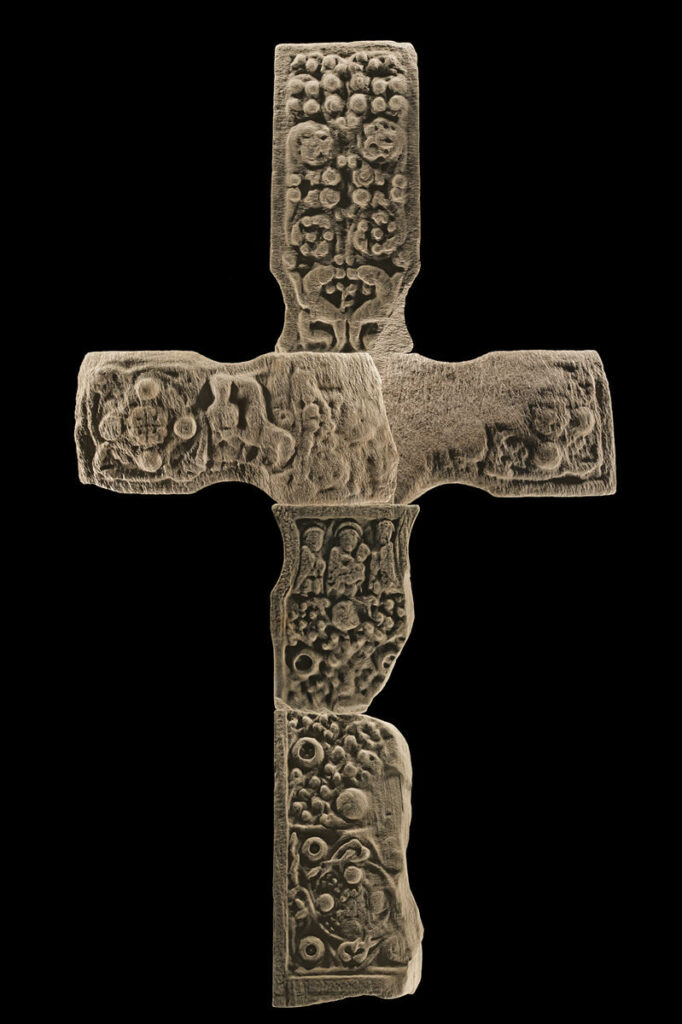
It is made from granite sourced from the Ross of Mull and features various biblical scenes. The most important depiction on St Oran’s cross is of the virgin and child. What distinguishes this early cross from the other crosses on the island is its lack of a ring.
St John’s Cross
Its museum neighbour, St John’s Cross, was also initially built without a ring. Made primarily of a chlorite-schist from the Mull of Kintyre, over 75 miles from Iona by boat. This stone was easier to work than more locally sourced stone, allowing for more precise carvings. On it you can see the snake and boss motif that would be found on many later crosses.
Within Christianity snakes are usually associated with evil, be that temptation as in Genesis or as a symbol of Satan. However, within Celtic Christianity they are often associated with resurrection thanks to the shedding of their skin. This likely has roots as a symbol within pre–Christian Celtic religious practices. St Johns cross therefore shows this fusion of the new and old religion, which gives the Celtic church its distinctive character within wider Christianity.
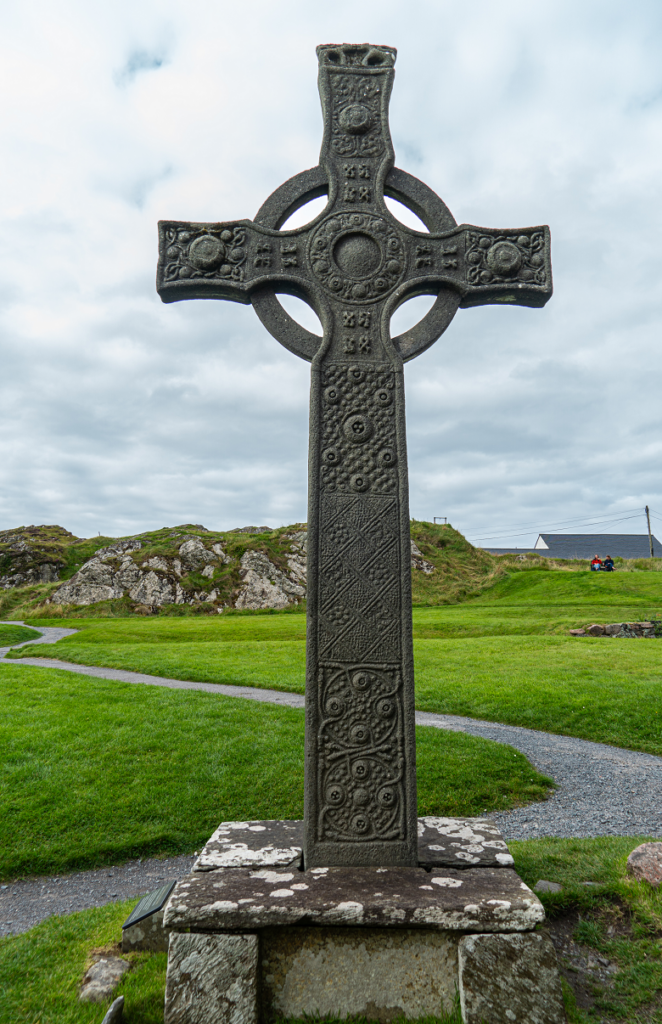
While an impressive structure and advancement in Celtic art, the cross was structurally weak. The 2.17m wingspan of the arms caused them to crack. It is now believed that the ring was added later to strengthen the structure. It’s likely that the birth of the iconic Celtic cross came from this simple practical necessity. Although the ring helped to stabilise the arms the sheer size of them made it top heavy and unbalanced. This led to it being blown over on several occasions. It was initially reconstructed in its original location outside St Columba’s shrine in the 1950s. Sadly, continued issues of stability led to it being moved to the museum. A concrete replica now stands in the spot of the original.
St Martin’s Cross
The legacy of the impact of St John’s cross can be seen in the later crosses of St Matthew’s and St Martin’s. St Martin’s cross is the only one of the early crosses still standing on its original spot. It dates from the mid 800s and it’s clear that lessons were learned from the problems of St John’s. The most notable difference between the two is the size of the arms. On St Martin’s they were made shorter to prevent it being top heavy. Slots were carved into the ends of the arms, allowing for wooden extensions to be slotted in on important feast days. However, the ring was kept, its inclusion being for symbolic rather than practical concerns, representing the eternal presence of Christ.
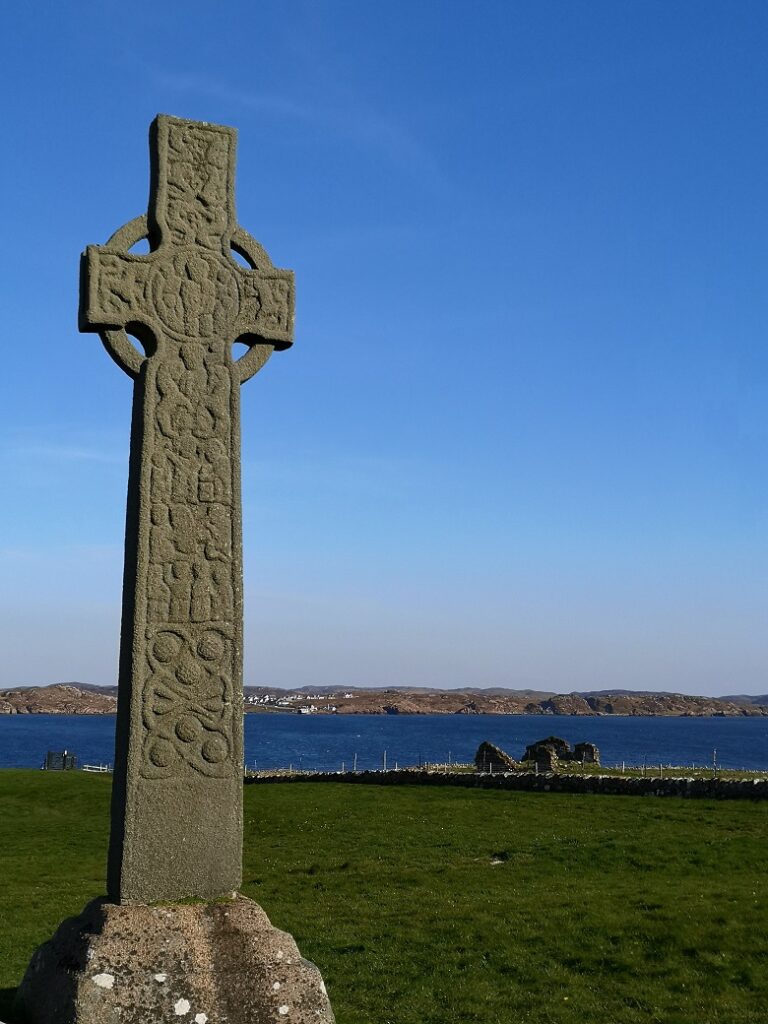
St Martin’s Cross, with ruins of St Marys chapel, Sound of Iona and Mull in the background. The snake and boss as well as the centring of the virgin and child shows how its creator was inspired by the earlier crosses of St Oran’s and St John’s. Image © Callum Forman.
Donald O’Brochlin and the tortured soul
Standing in the crossing of the abbey church and looking southeast one can clearly see some of the best carvings in the abbey. Here we see Adam and Eve covering their bodies along with the angel of expulsion. You can also find a giant mythical beast and a hound biting a bird. Most interesting of all, in my opinion, is the faint inscription in Latin which has been translated as ‘Donald O’Brochlin made this work.’
The O’Brochlins were master stonemasons in the 15th century. It’s likely that Donald was the lead mason during renovations to the church. Masons’ marks are not uncommon but this one is unusually large! It perhaps suggests that Donald was particularly proud of his work. It could have also been a form of self-promotion. Was Donald advertising his skills to pilgrims of means who visited the abbey?
One carving that people often miss is on the arch above the south west column. Known as the tortured soul, there are a few theories as to why it is there.
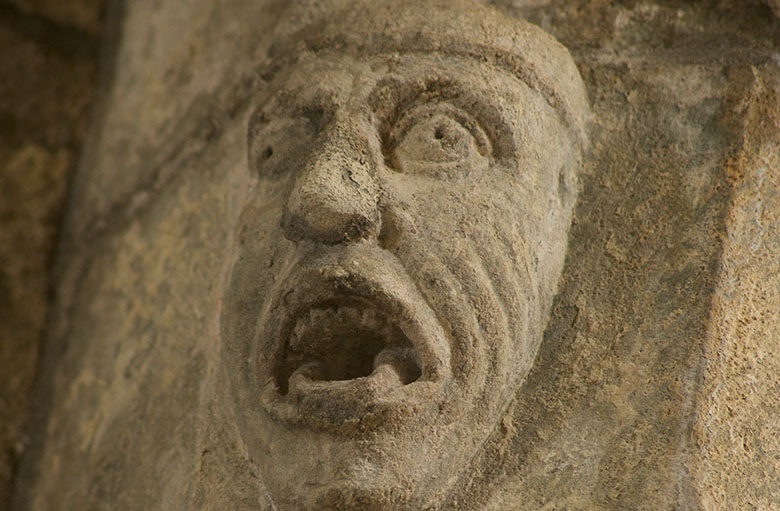
Carved face on west arch of the crossing, known as ‘The Tortured Soul.’
Some believe that it faces the choir to remind the monks and other preachers of their task when speaking to the lay people in the nave; it is their job to save their souls. Others think it had a more practical purpose as an acoustic device. If you stand in the correct spot and project your voice at it you can be heard around the whole church. My personal favourite theory though is that this is the other stone masons having a joke at old Donald’s expense. A cap can be seen atop the face’s brow; a common item of wear among stonemasons.
Dèan cabhag air ais/Haste ye back
This is a taster of the mysterious and magical tales surrounding Iona Abbey I collected over my time on the island. If you visit you’ll be able to discover others such as ‘The Tale of St Columba’s Pillow’, The battle of the white strand, and the humorous mistake on Abbot John MacKinnon tomb stone. Visiting Iona and speaking with the guides is a must for anyone interested in the history of Christianity in Scotland from the time of Columba to the present day.

